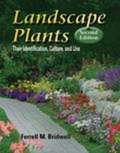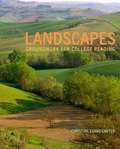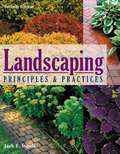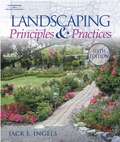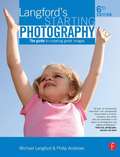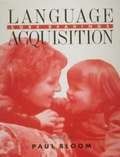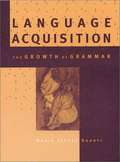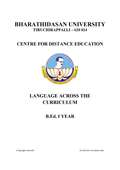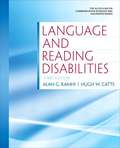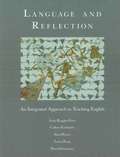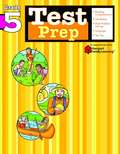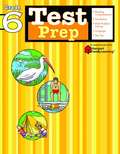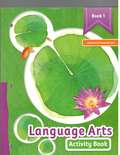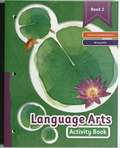- Table View
- List View
Landscape Plants: Their Identification, Culture, and Use (2nd edition)
by Ferrell M. BridwellIntended to help students, nursery people, landscape architects, educators, and homeowners in accurately identifying and growing an array of mostly typical woody landscape plants. A beginning chapter discusses plant identification and characteristics as well as the functional and aesthetic uses of plants. The remaining chapters present the plants, with one page of text and several passable color photos devoted to each. Information provided includes hardiness zones (mostly USDA zones 5 to 9), dimensions, fruit, texture, growth rate, culture, pest problems, habit, family, leaf and flower characteristics, selections and cultivars in cultivation, and landscape notes. Entries include ground covers; vines; dwarf, medium, and large shrubs; small, medium, and large trees; and grasses, palms, and bamboo.
Landscapes: Groundwork for College Reading
by Christine Evans CarterThis all-in-one book takes a metacognitive approach to teaching reading skills while integrating study strategies and vocabulary into every chapter in a meaningful way; offering modeled help as well as abundant, varied practice; and including two authentic textbook chapter applications for real-to-life academic readings students are expected to be able to complete.
Landscaping Principles & Practices
by Jack E. IngelsLandscaping: Principles & Pratices, 7th Edition provides the basic knowledge and industry information needed to be successful in the field of landscape design and architecture. Focusing on three areas of professional practice; design, contracting and management, traditional topics such as design, plant installation, and pricing are covered, as well as topics not found in most other books, such as interior landscaping, xeriscaping, water gardens, and safety.
Landscaping Principles And Practices (6th Edition)
by Jack E. IngelsNewly reorganized and updated, the fifth edition of this popular text offers a comprehensive introduction to landscape management. To present a balanced view of the industry as a process, the text is now organized by the industry's three career areas - design, contracting, and maintenance - to illustrate the interdependence of these areas. New material covers such current topics as xeriscaping and landscape calculations, providing students with the latest in landscaping techniques and management. Excellent for launching students into landscaping careers!
Landscaping: Principles and Practices (7th edition)
by Jack IngelsLandscaping: Principles & Practices, 7th Edition provides the basic knowledge and industry information needed to be successful in the field of landscape design and architecture. Focusing on three areas of professional practice; design, contracting and management, traditional topics such as design, plant installation, and pricing are covered, as well as topics not found in most other books, such as interior landscaping, xeriscaping, water gardens, and safety.
Langford's Starting Photography: The Guide to Creating Great Images
by Philip Andrews Michael Langford'The' Focal Press introductory photography book, this authoritative classic by leading photography writer and lecturer Michael Langford has been refreshed and revised by best-selling photography author Philip Andrews for today's photographers. Strongly focused on digital, but with key references to traditional photography where relevant, to offer a full grounding in the topic, Langford's Starting Photography is an ideal technical introduction. All the core basics are included, from how to select and compose a good picture to how different cameras operate and how to decipher their controls. Different subjects are explored, with advice on how to tackle people, places, animals, landscapes and close-ups, and valuable guidance on presenting and assessing finished work. This established, detailed beginner's guide is the perfect choice if you're looking to develop your knowledge and skills, and take your photography to the next level.
Language 3: Grammar, Creative Writing, Dictionary Skills Work-Text (Fourth Edition)
by Beverly Yarusinsky Darrell HolleyThe book is a writing and grammar work text that helps students to improve their grammar,creative writing and vocabulary.
Language Acquisition: Core Readings
by Paul BloomLanguage Acquisition offers, in one convenient reader, work by the most outstanding researchers in each field and is intended as a snapshot of the sort of theory and research taking place in language acquisition in the 1990s.
Language Acquisition: The Growth of Grammar
by Maria Teresa GuastiThis text provides a comprehensive introduction to current thinking on language acquisition. Following an introductory chapter that discusses the foundations of linguistic inquiry, the book covers the acquisition of specific aspects of language from birth to about age 6. Topics include the language abilities of newborns, the acquisition of phonological properties of language, the lexicon, syntax, pronoun and sentence interpretation, control structures, specific language impairments, and the relationship between language and other cognitive functions. At the conclusion of each chapter are a summary of the material covered, a list of keywords, study questions, and exercises. The book, which adopts the perspective of Chomskyan Universal Generative Grammar throughout, assumes a familiarity with basic concepts of linguistic theory.
Language Across The Curriculum
by Dr V. AmbedkarLanguage is a form and means of communication. It is intimately related to human beings since it is the universal and exclusive characteristic of man alone. It is the product of the human mind and the vocal apparatus which the human being possesses.
Language And Reading Disabilities
by Alan Kamhi Hugh CattsNow more than ever, increased attention has been given to students achieving adequate levels of reading proficiency. Maintaining its strong clinical and research basis, the third edition of Language and Reading Disabilities successfully keeps pace with the rapid changes in our knowledge about language and reading disabilities by providing readers with the most up-to-date advances in research and instruction in reading disabilities. This edition continues to cover a wide variety of theories by comparing and noting the similarities and differences between spoken and written language. This text is broad-based in its coverage of identification, assessment, and treatment of reading and writing disorders.
Language And Reflection: An Integrated Approach To Teaching English
by Anne Ruggles Gere Colleen Fairbanks Alan B. HowesThis methods book offers comprehensive coverage of English instruction built around a framework of theories of language... integrating material on literature, composition, and language into a cohesive blueprint for effective teaching.
Language Arts (Grade #5)
by Flash KidsThis book helps children improve the language skills to succeed. The book emphasizes skills in the key areas of: grammar, punctuation, vocabulary, writing, and research. The more than 100 lessons included in the book provide many opportunities to practice and apply important language and writing skills. These skills will help improve communication abilities, excel in all academic areas, and increase the scores on standardized tests.
Language Arts (Grade #6)
by Flash KidsThis book was developed to help your child improve the language skills he or she needs to succeed. The more than 100 lessons included in the book provide many opportunities for your child to practice and apply important language and writing skills. These skills will help your child improve his or her communication abilities, excel in all academic areas, and increase his or her scores on standardized tests.
Language Arts 5th Grade (Macmillan/McGraw-Hill Edition)
by Jan E. Hasbrouck Donna Lubcker Sharon O'Neal William H. Teale Josefina V Tinajero Karen D. WoodMacmillian/McGraw-Hill Language Arts can help the student become the best writer and user of language that they can possibly be.
Language Arts Today (Grade 8, Classic Edition)
by Ann Mccallum William Strong Tina ThoburnThe Contents of the book are: Sentences, Writing Personal Narratives, Nouns, Writing stories, Verbs, Writing Explanations, Pronouns, Writing Biographical Sketches, Adjectives and Adverbs, Writing Descriptions, Prepositions, Conjunctions, and Interjections, Writing Editorials, Complex Sentences and Verbals, Writing Research Reports, etc.
